Problem - Solution pattern in English online brief news on Vietnam
Nowadays, presses in general and online
press in particular have become more and more
popular means of communication. A lot of
people search webs to find information and one
of their favorite places is online brief news.
Online brief news is said to be a useful and
typical demonstration of text patterns. It is
where the authors often convey as sufficient
information as possible within the limit of news
and it is also a place where certain features of
language are clearly manifested.
Text patterns play important roles in
organizing a discourse. In English discourses,
such patterns as problem-solution pattern,
general- specific pattern, claim-counter claim
pattern, advantage-disadvantage pattern are
most usually used in organizing a discourse.
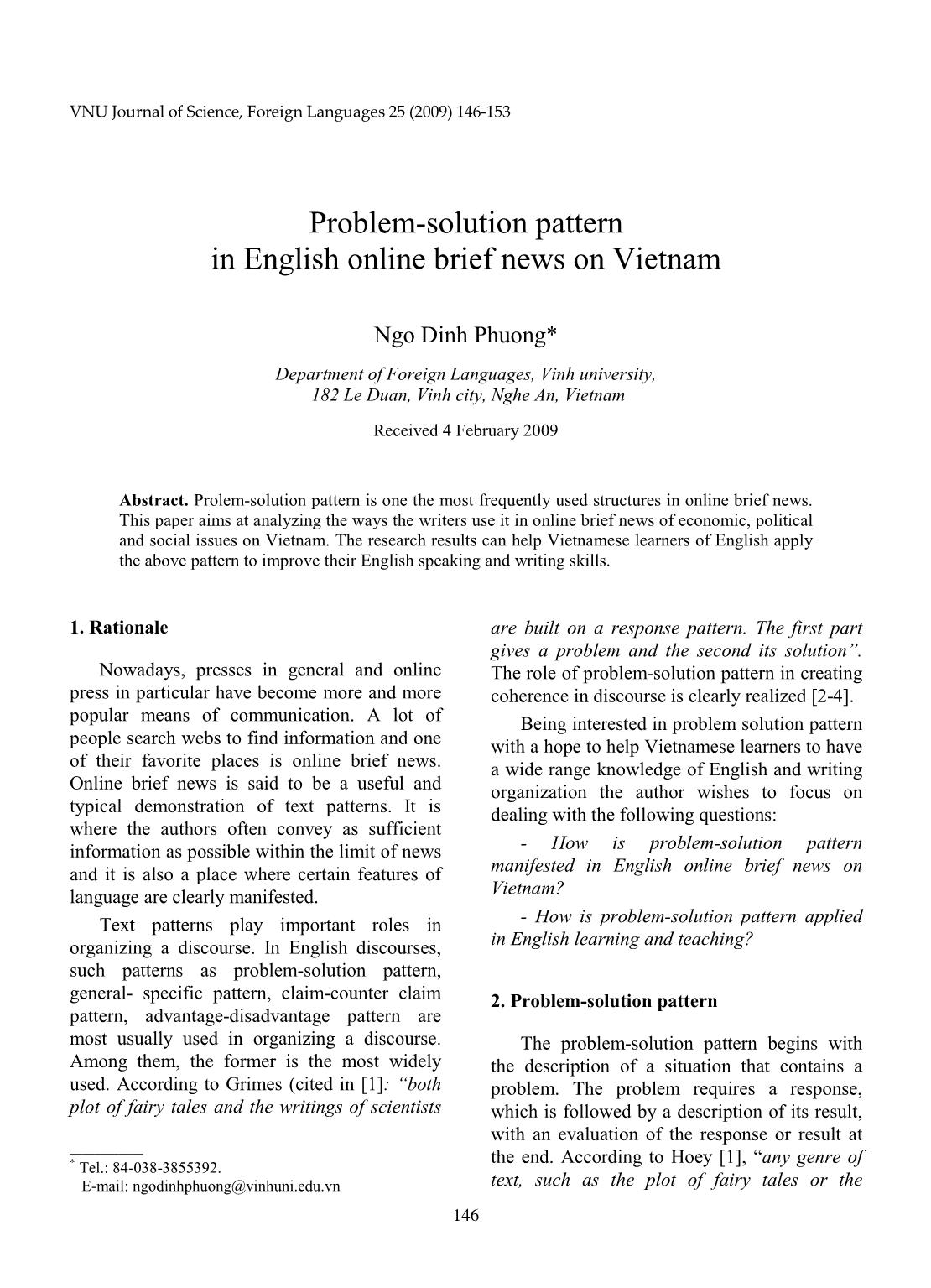
Trang 1
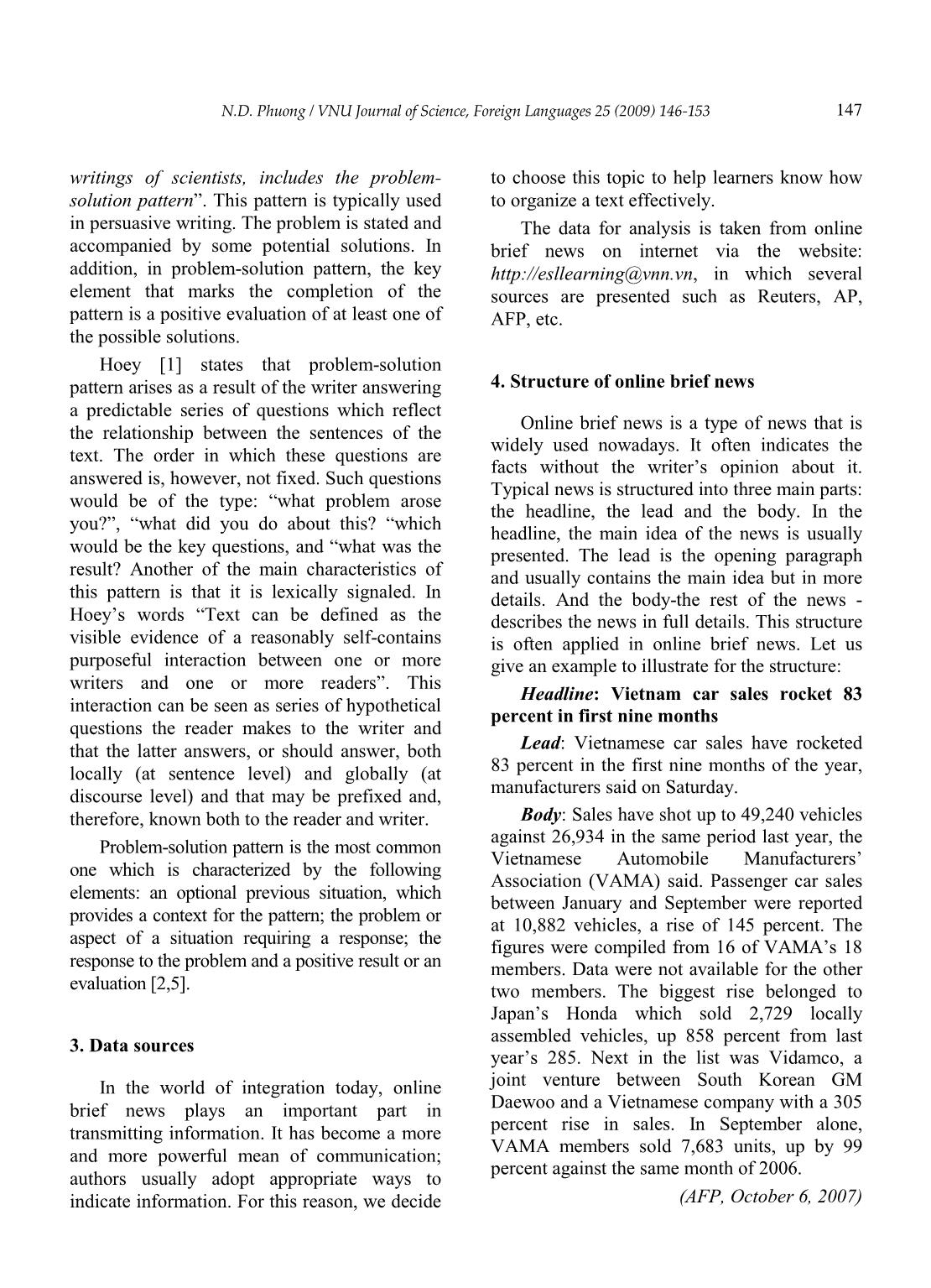
Trang 2

Trang 3
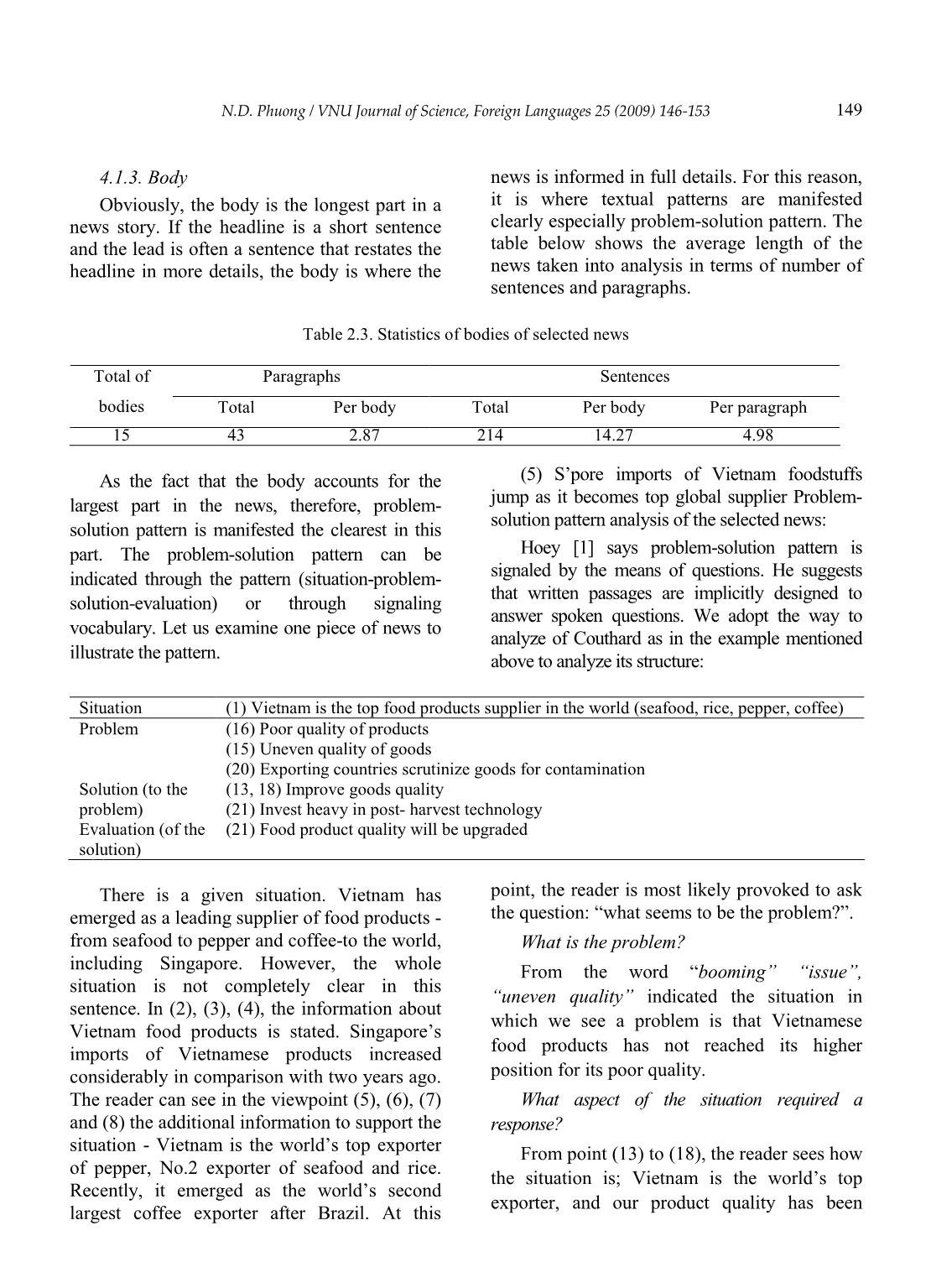
Trang 4
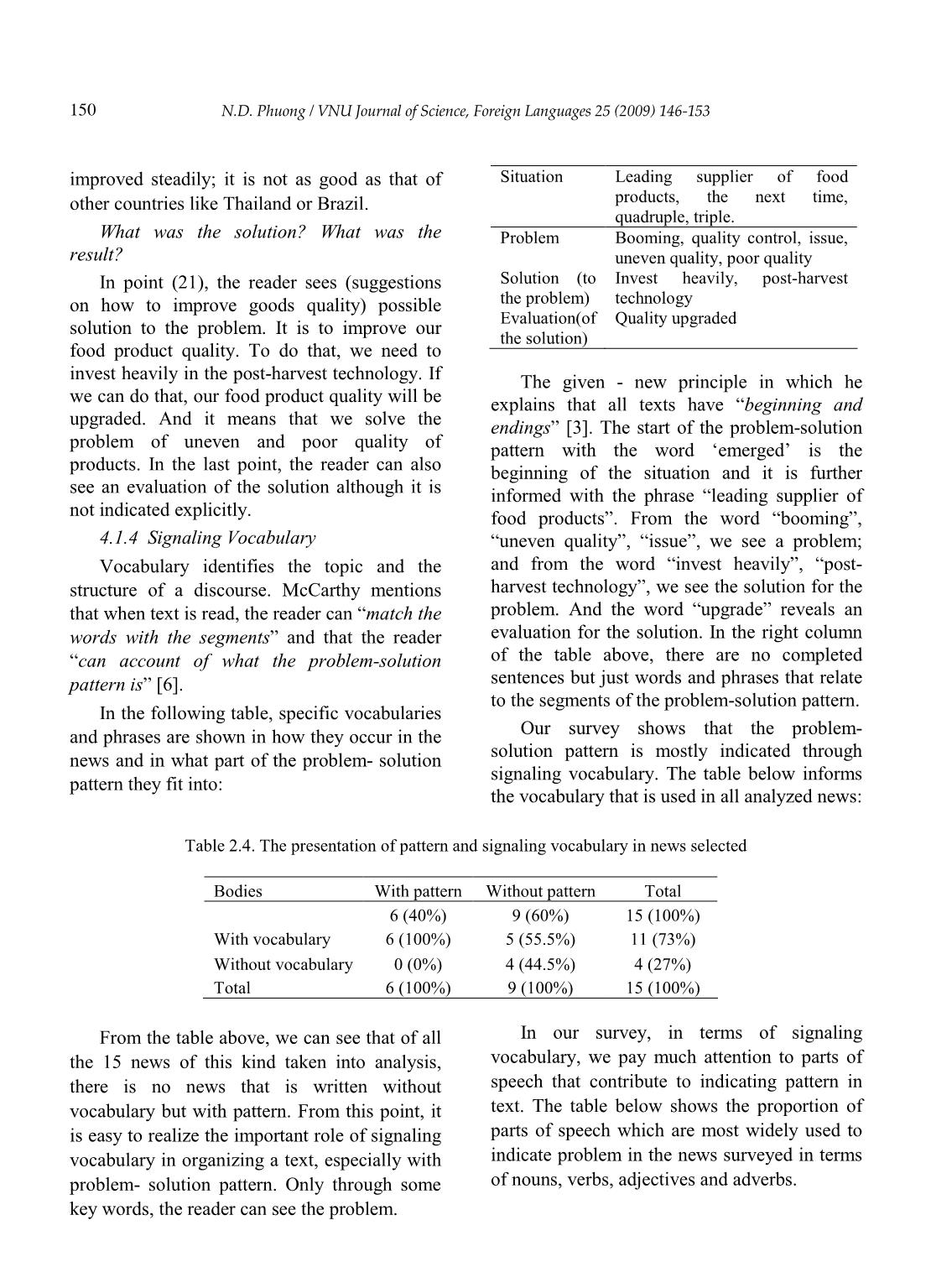
Trang 5
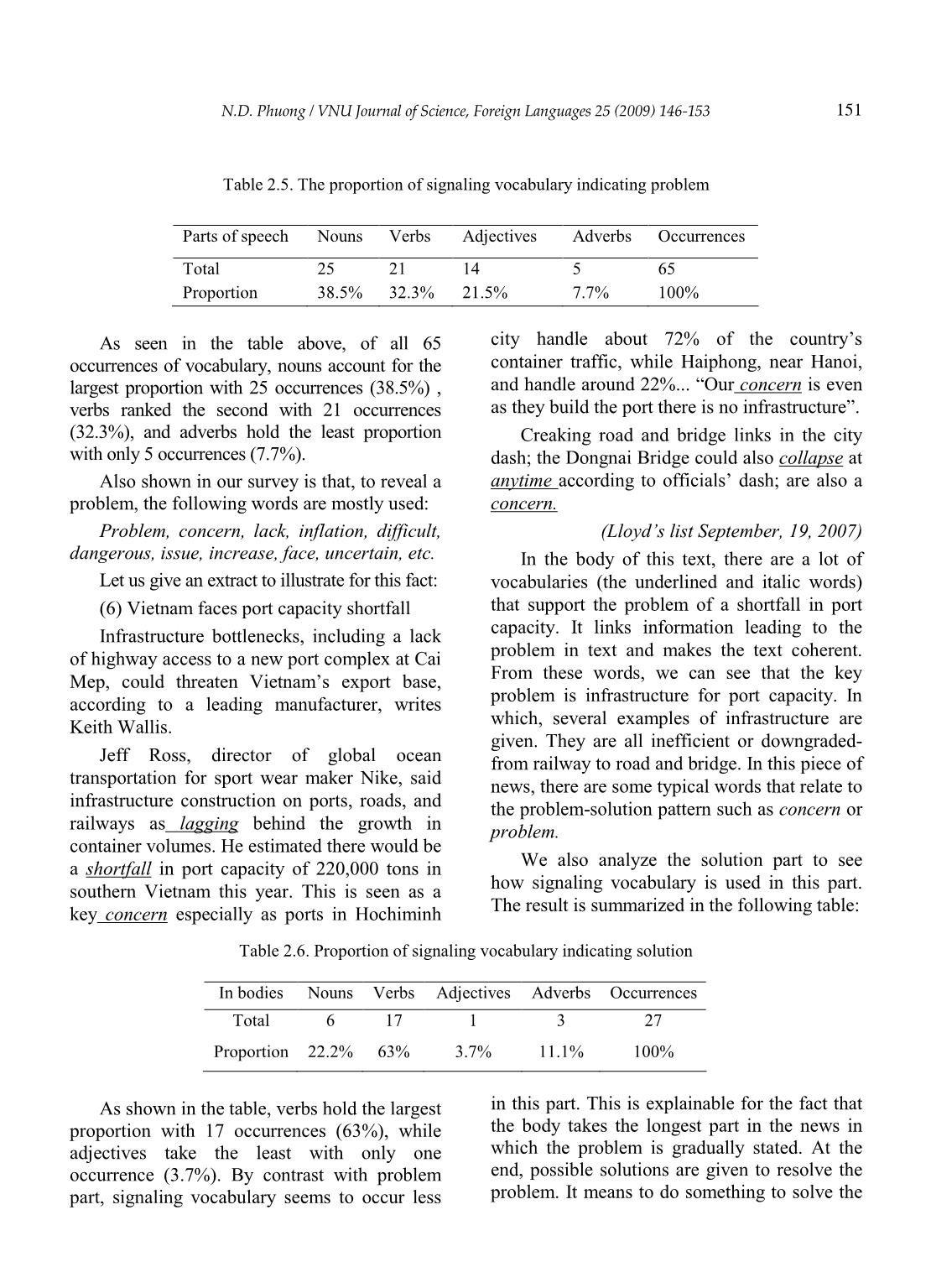
Trang 6
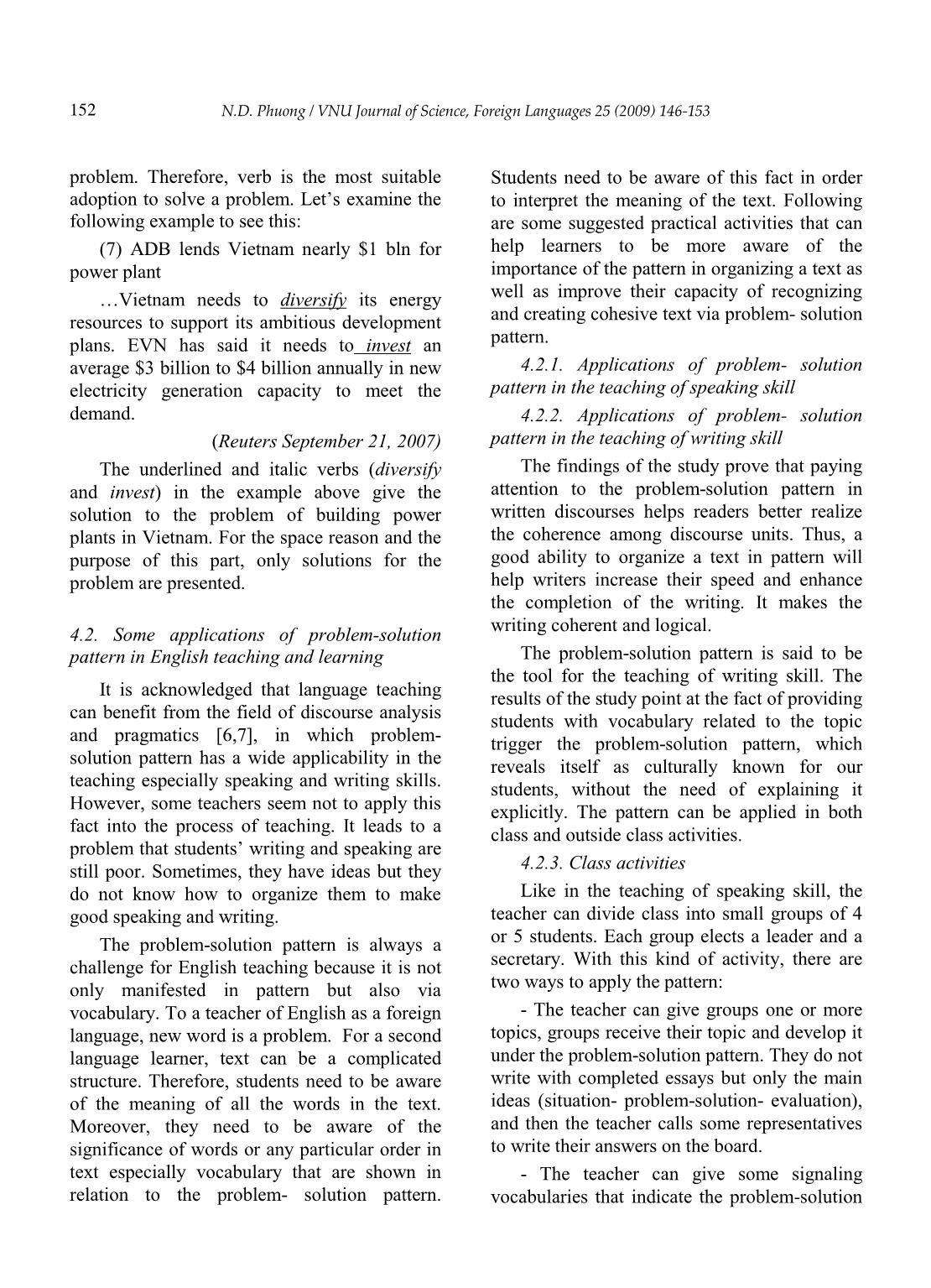
Trang 7
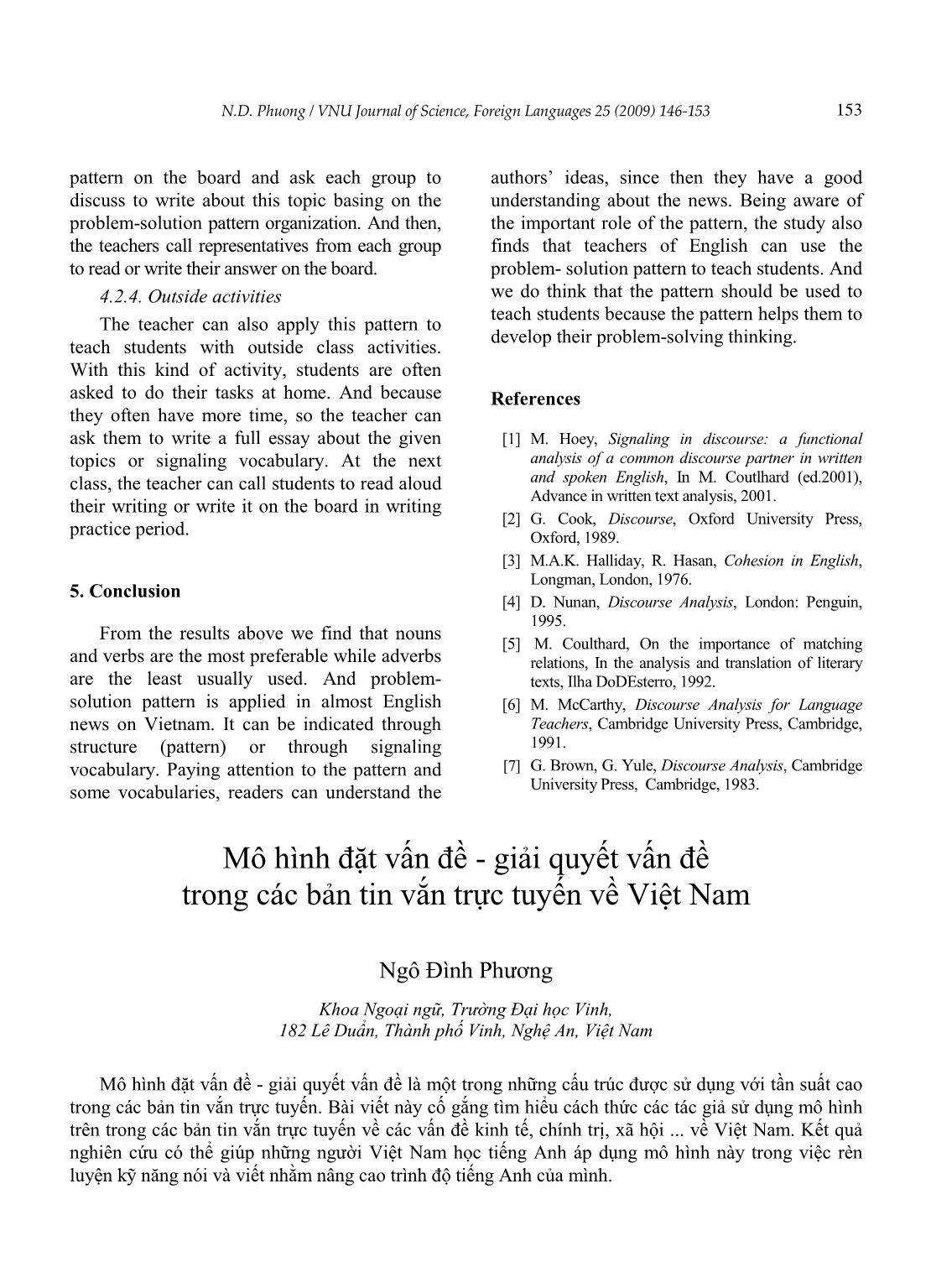
Trang 8
Tóm tắt nội dung tài liệu: Problem - Solution pattern in English online brief news on Vietnam
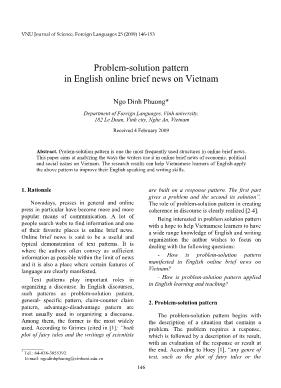
VNU Journal of Science, Foreign Languages 25 (2009) 146-153 146 Problem-solution pattern in English online brief news on Vietnam Ngo Dinh Phuong* Department of Foreign Languages, Vinh university, 182 Le Duan, Vinh city, Nghe An, Vietnam Received 4 February 2009 Abstract. Prolem-solution pattern is one the most frequently used structures in online brief news. This paper aims at analyzing the ways the writers use it in online brief news of economic, political and social issues on Vietnam. The research results can help Vietnamese learners of English apply the above pattern to improve their English speaking and writing skills. 1. Rationale* Nowadays, presses in general and online press in particular have become more and more popular means of communication. A lot of people search webs to find information and one of their favorite places is online brief news. Online brief news is said to be a useful and typical demonstration of text patterns. It is where the authors often convey as sufficient information as possible within the limit of news and it is also a place where certain features of language are clearly manifested. Text patterns play important roles in organizing a discourse. In English discourses, such patterns as problem-solution pattern, general- specific pattern, claim-counter claim pattern, advantage-disadvantage pattern are most usually used in organizing a discourse. Among them, the former is the most widely used. According to Grimes (cited in [1]: “both plot of fairy tales and the writings of scientists ______ * Tel.: 84-038-3855392. E-mail: ngodinhphuong@vinhuni.edu.vn are built on a response pattern. The first part gives a problem and the second its solution”. The role of problem-solution pattern in creating coherence in discourse is clearly realized [2-4]. Being interested in problem solution pattern with a hope to help Vietnamese learners to have a wide range knowledge of English and writing organization the author wishes to focus on dealing with the following questions: - How is problem-solution pattern manifested in English online brief news on Vietnam? - How is problem-solution pattern applied in English learning and teaching? 2. Problem-solution pattern The problem-solution pattern begins with the description of a situation that contains a problem. The problem requires a response, which is followed by a description of its result, with an evaluation of the response or result at the end. According to Hoey [1], “any genre of text, such as the plot of fairy tales or the N.D. Phuong / VNU Journal of Science, Foreign Languages 25 (2009) 146-153 147 writings of scientists, includes the problem- solution pattern”. This pattern is typically used in persuasive writing. The problem is stated and accompanied by some potential solutions. In addition, in problem-solution pattern, the key element that marks the completion of the pattern is a positive evaluation of at least one of the possible solutions. Hoey [1] states that problem-solution pattern arises as a result of the writer answering a predictable series of questions which reflect the relationship between the sentences of the text. The order in which these questions are answered is, however, not fixed. Such questions would be of the type: “what problem arose you?”, “what did you do about this? “which would be the key questions, and “what was the result? Another of the main characteristics of this pattern is that it is lexically signaled. In Hoey’s words “Text can be defined as the visible evidence of a reasonably self-contains purposeful interaction between one or more writers and one or more readers”. This interaction can be seen as series of hypothetical questions the reader makes to the writer and that the latter answers, or should answer, both locally (at sentence level) and globally (at discourse level) and that may be prefixed and, therefore, known both to the reader and writer. Problem-solution pattern is the most common one which is characterized by the following elements: an optional previous situation, which provides a context for the pattern; the problem or aspect of a situation requiring a response; the response to the problem and a positive result or an evaluation [2,5]. 3. Data sources In the world of integration today, online brief news plays an important part in transmitting information. It has become a more and more powerful mean of communication; authors usually adopt appropriate ways to indicate information. For this reason, we decide to choose this topic to help learners know how to organize a text effectively. The data for analysis is taken from online brief news on internet via the website: in which several sources are presented such as Reuters, AP, AFP, etc. 4. Structure of online brief news Online brief news is a type of news that is widely used nowadays. It often indicates the facts without the writer’s opinion about it. Typical news is structured into three main parts: the headline, the lead and the body. In the headline, the main idea of the news is usually presented. The lead is the opening paragraph and usually contains the main idea but in more details. And the body-the rest of the news - describes the news in full details. This structure is often applied in online brief news. Let us give an example to illustrate for the structure: Headline: Vietnam car sales rocket 83 percent in first nine months Lead: Vietnamese car sales have rocketed 83 percent in the first nine months of the year, manufacturers said on Saturday. Body: Sales have shot up to 49,240 vehicles against 26,934 in the same period last year, the Vietnamese Automobile Manufacturers’ Association (VAMA) said. Passenger car sales between January and September were reported at 1 ... en quality” indicated the situation in which we see a problem is that Vietnamese food products has not reached its higher position for its poor quality. What aspect of the situation required a response? From point (13) to (18), the reader sees how the situation is; Vietnam is the world’s top exporter, and our product quality has been N.D. Phuong / VNU Journal of Science, Foreign Languages 25 (2009) 146-153 150 improved steadily; it is not as good as that of other countries like Thailand or Brazil. What was the solution? What was the result? In point (21), the reader sees (suggestions on how to improve goods quality) possible solution to the problem. It is to improve our food product quality. To do that, we need to invest heavily in the post-harvest technology. If we can do that, our food product quality will be upgraded. And it means that we solve the problem of uneven and poor quality of products. In the last point, the reader can also see an evaluation of the solution although it is not indicated explicitly. 4.1.4 Signaling Vocabulary Vocabulary identifies the topic and the structure of a discourse. McCarthy mentions that when text is read, the reader can “match the words with the segments” and that the reader “can account of what the problem-solution pattern is” [6]. In the following table, specific vocabularies and phrases are shown in how they occur in the news and in what part of the problem- solution pattern they fit into: Situation Leading supplier of food products, the next time, quadruple, triple. Problem Booming, quality control, issue, uneven quality, poor quality Solution (to the problem) Invest heavily, post-harvest technology Evaluation(of the solution) Quality upgraded The given - new principle in which he explains that all texts have “beginning and endings” [3]. The start of the problem-solution pattern with the word ‘emerged’ is the beginning of the situation and it is further informed with the phrase “leading supplier of food products”. From the word “booming”, “uneven quality”, “issue”, we see a problem; and from the word “invest heavily”, “post- harvest technology”, we see the solution for the problem. And the word “upgrade” reveals an evaluation for the solution. In the right column of the table above, there are no completed sentences but just words and phrases that relate to the segments of the problem-solution pattern. Our survey shows that the problem- solution pattern is mostly indicated through signaling vocabulary. The table below informs the vocabulary that is used in all analyzed news: Table 2.4. The presentation of pattern and signaling vocabulary in news selected Bodies With pattern Without pattern Total 6 (40%) 9 (60%) 15 (100%) With vocabulary 6 (100%) 5 (55.5%) 11 (73%) Without vocabulary 0 (0%) 4 (44.5%) 4 (27%) Total 6 (100%) 9 (100%) 15 (100%) gjkk From the table above, we can see that of all the 15 news of this kind taken into analysis, there is no news that is written without vocabulary but with pattern. From this point, it is easy to realize the important role of signaling vocabulary in organizing a text, especially with problem- solution pattern. Only through some key words, the reader can see the problem. In our survey, in terms of signaling vocabulary, we pay much attention to parts of speech that contribute to indicating pattern in text. The table below shows the proportion of parts of speech which are most widely used to indicate problem in the news surveyed in terms of nouns, verbs, adjectives and adverbs. N.D. Phuong / VNU Journal of Science, Foreign Languages 25 (2009) 146-153 151 Table 2.5. The proportion of signaling vocabulary indicating problem Parts of speech Nouns Verbs Adjectives Adverbs Occurrences Total 25 21 14 5 65 Proportion 38.5% 32.3% 21.5% 7.7% 100% Table 2.5. The proportion of signaling vocabulary indicating problem As seen in the table above, of all 65 occurrences of vocabulary, nouns account for the largest proportion with 25 occurrences (38.5%) , verbs ranked the second with 21 occurrences (32.3%), and adverbs hold the least proportion with only 5 occurrences (7.7%). Also shown in our survey is that, to reveal a problem, the following words are mostly used: Problem, concern, lack, inflation, difficult, dangerous, issue, increase, face, uncertain, etc. Let us give an extract to illustrate for this fact: (6) Vietnam faces port capacity shortfall Infrastructure bottlenecks, including a lack of highway access to a new port complex at Cai Mep, could threaten Vietnam’s export base, according to a leading manufacturer, writes Keith Wallis. Jeff Ross, director of global ocean transportation for sport wear maker Nike, said infrastructure construction on ports, roads, and railways as lagging behind the growth in container volumes. He estimated there would be a shortfall in port capacity of 220,000 tons in southern Vietnam this year. This is seen as a key concern especially as ports in Hochiminh city handle about 72% of the country’s container traffic, while Haiphong, near Hanoi, and handle around 22%... “Our concern is even as they build the port there is no infrastructure”. Creaking road and bridge links in the city dash; the Dongnai Bridge could also collapse at anytime according to officials’ dash; are also a concern. (Lloyd’s list September, 19, 2007) In the body of this text, there are a lot of vocabularies (the underlined and italic words) that support the problem of a shortfall in port capacity. It links information leading to the problem in text and makes the text coherent. From these words, we can see that the key problem is infrastructure for port capacity. In which, several examples of infrastructure are given. They are all inefficient or downgraded- from railway to road and bridge. In this piece of news, there are some typical words that relate to the problem-solution pattern such as concern or problem. We also analyze the solution part to see how signaling vocabulary is used in this part. The result is summarized in the following table: Table 2.6. Proportion of signaling vocabulary indicating solution In bodies Nouns Verbs Adjectives Adverbs Occurrences Total 6 17 1 3 27 Proportion 22.2% 63% 3.7% 11.1% 100% Table 2.6. Proportion of signaling vocabulary indicating solution As shown in the table, verbs hold the largest proportion with 17 occurrences (63%), while adjectives take the least with only one occurrence (3.7%). By contrast with problem part, signaling vocabulary seems to occur less in this part. This is explainable for the fact that the body takes the longest part in the news in which the problem is gradually stated. At the end, possible solutions are given to resolve the problem. It means to do something to solve the N.D. Phuong / VNU Journal of Science, Foreign Languages 25 (2009) 146-153 152 problem. Therefore, verb is the most suitable adoption to solve a problem. Let’s examine the following example to see this: (7) ADB lends Vietnam nearly $1 bln for power plant Vietnam needs to diversify its energy resources to support its ambitious development plans. EVN has said it needs to invest an average $3 billion to $4 billion annually in new electricity generation capacity to meet the demand. (Reuters September 21, 2007) The underlined and italic verbs (diversify and invest) in the example above give the solution to the problem of building power plants in Vietnam. For the space reason and the purpose of this part, only solutions for the problem are presented. 4.2. Some applications of problem-solution pattern in English teaching and learning It is acknowledged that language teaching can benefit from the field of discourse analysis and pragmatics [6,7], in which problem- solution pattern has a wide applicability in the teaching especially speaking and writing skills. However, some teachers seem not to apply this fact into the process of teaching. It leads to a problem that students’ writing and speaking are still poor. Sometimes, they have ideas but they do not know how to organize them to make good speaking and writing. The problem-solution pattern is always a challenge for English teaching because it is not only manifested in pattern but also via vocabulary. To a teacher of English as a foreign language, new word is a problem. For a second language learner, text can be a complicated structure. Therefore, students need to be aware of the meaning of all the words in the text. Moreover, they need to be aware of the significance of words or any particular order in text especially vocabulary that are shown in relation to the problem- solution pattern. Students need to be aware of this fact in order to interpret the meaning of the text. Following are some suggested practical activities that can help learners to be more aware of the importance of the pattern in organizing a text as well as improve their capacity of recognizing and creating cohesive text via problem- solution pattern. 4.2.1. Applications of problem- solution pattern in the teaching of speaking skill 4.2.2. Applications of problem- solution pattern in the teaching of writing skill The findings of the study prove that paying attention to the problem-solution pattern in written discourses helps readers better realize the coherence among discourse units. Thus, a good ability to organize a text in pattern will help writers increase their speed and enhance the completion of the writing. It makes the writing coherent and logical. The problem-solution pattern is said to be the tool for the teaching of writing skill. The results of the study point at the fact of providing students with vocabulary related to the topic trigger the problem-solution pattern, which reveals itself as culturally known for our students, without the need of explaining it explicitly. The pattern can be applied in both class and outside class activities. 4.2.3. Class activities Like in the teaching of speaking skill, the teacher can divide class into small groups of 4 or 5 students. Each group elects a leader and a secretary. With this kind of activity, there are two ways to apply the pattern: - The teacher can give groups one or more topics, groups receive their topic and develop it under the problem-solution pattern. They do not write with completed essays but only the main ideas (situation- problem-solution- evaluation), and then the teacher calls some representatives to write their answers on the board. - The teacher can give some signaling vocabularies that indicate the problem-solution N.D. Phuong / VNU Journal of Science, Foreign Languages 25 (2009) 146-153 153 pattern on the board and ask each group to discuss to write about this topic basing on the problem-solution pattern organization. And then, the teachers call representatives from each group to read or write their answer on the board. 4.2.4. Outside activities The teacher can also apply this pattern to teach students with outside class activities. With this kind of activity, students are often asked to do their tasks at home. And because they often have more time, so the teacher can ask them to write a full essay about the given topics or signaling vocabulary. At the next class, the teacher can call students to read aloud their writing or write it on the board in writing practice period. 5. Conclusion From the results above we find that nouns and verbs are the most preferable while adverbs are the least usually used. And problem- solution pattern is applied in almost English news on Vietnam. It can be indicated through structure (pattern) or through signaling vocabulary. Paying attention to the pattern and some vocabularies, readers can understand the authors’ ideas, since then they have a good understanding about the news. Being aware of the important role of the pattern, the study also finds that teachers of English can use the problem- solution pattern to teach students. And we do think that the pattern should be used to teach students because the pattern helps them to develop their problem-solving thinking. References [1] M. Hoey, Signaling in discourse: a functional analysis of a common discourse partner in written and spoken English, In M. Coutlhard (ed.2001), Advance in written text analysis, 2001. [2] G. Cook, Discourse, Oxford University Press, Oxford, 1989. [3] M.A.K. Halliday, R. Hasan, Cohesion in English, Longman, London, 1976. [4] D. Nunan, Discourse Analysis, London: Penguin, 1995. [5] M. Coulthard, On the importance of matching relations, In the analysis and translation of literary texts, Ilha DoDEsterro, 1992. [6] M. McCarthy, Discourse Analysis for Language Teachers, Cambridge University Press, Cambridge, 1991. [7] G. Brown, G. Yule, Discourse Analysis, Cambridge University Press, Cambridge, 1983. Mô hình đặt vấn đề - giải quyết vấn đề trong các bản tin vắn trực tuyến về Việt Nam Ngô Đình Phương Khoa Ngoại ngữ, Trường Đại học Vinh, 182 Lê Duẩn, Thành phố Vinh, Nghệ An, Việt Nam Mô hình đặt vấn đề - giải quyết vấn đề là một trong những cấu trúc được sử dụng với tần suất cao trong các bản tin vắn trực tuyến. Bài viết này cố gắng tìm hiểu cách thức các tác giả sử dụng mô hình trên trong các bản tin vắn trực tuyến về các vấn đề kinh tế, chính trị, xã hội ... về Việt Nam. Kết quả nghiên cứu có thể giúp những người Việt Nam học tiếng Anh áp dụng mô hình này trong việc rèn luyện kỹ năng nói và viết nhằm nâng cao trình độ tiếng Anh của mình.
File đính kèm:
 problem_solution_pattern_in_english_online_brief_news_on_vie.pdf
problem_solution_pattern_in_english_online_brief_news_on_vie.pdf

